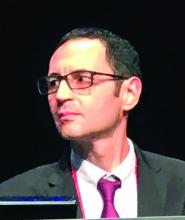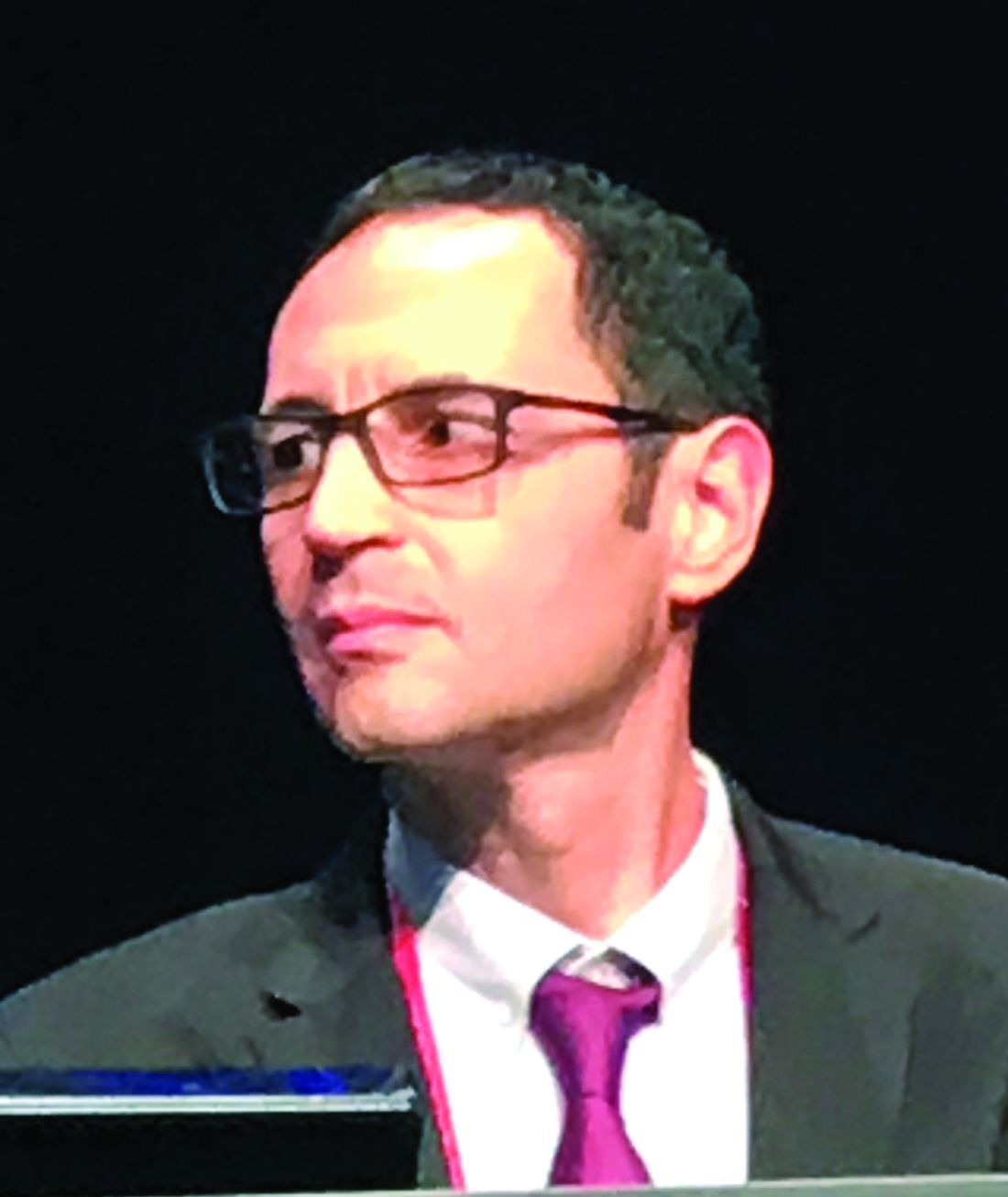User login
MADRID – according to a multicenter trial presented at the annual congress of the European Respiratory Congress.
Both therapies are widely used in the treatment of CTEPH, but this is the first controlled trial in which they were directly compared, according to Xavier Jaïs, MD, of the Pulmonology Service, Kremlin-Bicêtre Hospital, University of Paris-Sud.
In this randomized trial, called RACE, newly diagnosed and previously untreated patients with nonoperable CTEPH were enrolled. The key eligibility criteria included PVR greater than 320 dynes/sec per cm–5 and a pulmonary capillary wedge pressure of 15 mm Hg or less.
The patients were randomized to BPA or riociguat and followed for 26 weeks. The primary endpoint was relative change in PVR from baseline. The 6-minute walk distance, change in functional class, time to clinical worsening and safety were among secondary endpoints.
As calculated by geometric mean from baseline, PVR was reduced by nearly 60% in the BPA group and by 32% in the riociguat group, providing a 40% (P less than .0001) relative advantage of BPA.
Although there was a small relative advantage in the 6-minute walk distance for the BPA group at the end of the study, it did not reach statistical significant. However, 88% of those randomized to BPA versus 49% of those treated with riociguat (P less than .0001) improved by at least one WHO class by the end of the study.
Clinical worsening events over the course of the trial were uncommon. All three of these events occurred in the riociguat group, but the difference was not significant.
The end-of-study reduction in brain natriuretic peptide, which was another secondary endpoint, was 67% greater in the BPA group (P less than .0001).
There was a safety cost for the greater efficacy of BPA. This included a higher proportion of patients in the BPA group with at least one serious adverse event (50% vs. 26%) and at least one serious treatment-related adverse event (14% vs. 9%). No patient in either arm discontinued therapy because of treatment-related adverse events, and there were no deaths over the course of the study in either arm.
The study has included a 6-month extension to allow patients symptomatic on their originally assigned therapy to switch to the opposite treatment. Results of the extension are not yet available, but Dr. Jaïs said that these data might provide insight about which therapy to start first.
“It was very important to do this trial,” according to the ERS-invited discussant, Martin Kolb, MD, of the Firestone Institute of Respiratory Health, McMaster University, Hamilton, Ont. The most recent World Symposium on Pulmonary Hypertension identified BPA and medical therapy as reasonable choices in inoperable CTEPH, but Dr. Kolb said there has been an unmet need for comparative data.
“This was a very strong study that demonstrated a powerful impact for both interventions on pulmonary vascular resistance,” Dr. Kolb said, adding that, although BPA proved to be more effective, clinicians consider the greater risk of adverse events. He believes further work needs to be done in identifying the best candidates for each and to explore hybrid approaches.
“What do you think about doing these sequentially so that you lower the pressure first with medical therapy and then go in with the balloon?” Dr. Kolb asked Dr. Jaïs during a discussion that followed presentation of the RACE results.
Dr. Jaïs conceded this point, noting that the treatments have different targets and might be complementary.
“We plan to do a study like this in the future,” Dr. Jaïs said.
Dr. Jaïs reported no potential conflicts of interest.
MADRID – according to a multicenter trial presented at the annual congress of the European Respiratory Congress.
Both therapies are widely used in the treatment of CTEPH, but this is the first controlled trial in which they were directly compared, according to Xavier Jaïs, MD, of the Pulmonology Service, Kremlin-Bicêtre Hospital, University of Paris-Sud.
In this randomized trial, called RACE, newly diagnosed and previously untreated patients with nonoperable CTEPH were enrolled. The key eligibility criteria included PVR greater than 320 dynes/sec per cm–5 and a pulmonary capillary wedge pressure of 15 mm Hg or less.
The patients were randomized to BPA or riociguat and followed for 26 weeks. The primary endpoint was relative change in PVR from baseline. The 6-minute walk distance, change in functional class, time to clinical worsening and safety were among secondary endpoints.
As calculated by geometric mean from baseline, PVR was reduced by nearly 60% in the BPA group and by 32% in the riociguat group, providing a 40% (P less than .0001) relative advantage of BPA.
Although there was a small relative advantage in the 6-minute walk distance for the BPA group at the end of the study, it did not reach statistical significant. However, 88% of those randomized to BPA versus 49% of those treated with riociguat (P less than .0001) improved by at least one WHO class by the end of the study.
Clinical worsening events over the course of the trial were uncommon. All three of these events occurred in the riociguat group, but the difference was not significant.
The end-of-study reduction in brain natriuretic peptide, which was another secondary endpoint, was 67% greater in the BPA group (P less than .0001).
There was a safety cost for the greater efficacy of BPA. This included a higher proportion of patients in the BPA group with at least one serious adverse event (50% vs. 26%) and at least one serious treatment-related adverse event (14% vs. 9%). No patient in either arm discontinued therapy because of treatment-related adverse events, and there were no deaths over the course of the study in either arm.
The study has included a 6-month extension to allow patients symptomatic on their originally assigned therapy to switch to the opposite treatment. Results of the extension are not yet available, but Dr. Jaïs said that these data might provide insight about which therapy to start first.
“It was very important to do this trial,” according to the ERS-invited discussant, Martin Kolb, MD, of the Firestone Institute of Respiratory Health, McMaster University, Hamilton, Ont. The most recent World Symposium on Pulmonary Hypertension identified BPA and medical therapy as reasonable choices in inoperable CTEPH, but Dr. Kolb said there has been an unmet need for comparative data.
“This was a very strong study that demonstrated a powerful impact for both interventions on pulmonary vascular resistance,” Dr. Kolb said, adding that, although BPA proved to be more effective, clinicians consider the greater risk of adverse events. He believes further work needs to be done in identifying the best candidates for each and to explore hybrid approaches.
“What do you think about doing these sequentially so that you lower the pressure first with medical therapy and then go in with the balloon?” Dr. Kolb asked Dr. Jaïs during a discussion that followed presentation of the RACE results.
Dr. Jaïs conceded this point, noting that the treatments have different targets and might be complementary.
“We plan to do a study like this in the future,” Dr. Jaïs said.
Dr. Jaïs reported no potential conflicts of interest.
MADRID – according to a multicenter trial presented at the annual congress of the European Respiratory Congress.
Both therapies are widely used in the treatment of CTEPH, but this is the first controlled trial in which they were directly compared, according to Xavier Jaïs, MD, of the Pulmonology Service, Kremlin-Bicêtre Hospital, University of Paris-Sud.
In this randomized trial, called RACE, newly diagnosed and previously untreated patients with nonoperable CTEPH were enrolled. The key eligibility criteria included PVR greater than 320 dynes/sec per cm–5 and a pulmonary capillary wedge pressure of 15 mm Hg or less.
The patients were randomized to BPA or riociguat and followed for 26 weeks. The primary endpoint was relative change in PVR from baseline. The 6-minute walk distance, change in functional class, time to clinical worsening and safety were among secondary endpoints.
As calculated by geometric mean from baseline, PVR was reduced by nearly 60% in the BPA group and by 32% in the riociguat group, providing a 40% (P less than .0001) relative advantage of BPA.
Although there was a small relative advantage in the 6-minute walk distance for the BPA group at the end of the study, it did not reach statistical significant. However, 88% of those randomized to BPA versus 49% of those treated with riociguat (P less than .0001) improved by at least one WHO class by the end of the study.
Clinical worsening events over the course of the trial were uncommon. All three of these events occurred in the riociguat group, but the difference was not significant.
The end-of-study reduction in brain natriuretic peptide, which was another secondary endpoint, was 67% greater in the BPA group (P less than .0001).
There was a safety cost for the greater efficacy of BPA. This included a higher proportion of patients in the BPA group with at least one serious adverse event (50% vs. 26%) and at least one serious treatment-related adverse event (14% vs. 9%). No patient in either arm discontinued therapy because of treatment-related adverse events, and there were no deaths over the course of the study in either arm.
The study has included a 6-month extension to allow patients symptomatic on their originally assigned therapy to switch to the opposite treatment. Results of the extension are not yet available, but Dr. Jaïs said that these data might provide insight about which therapy to start first.
“It was very important to do this trial,” according to the ERS-invited discussant, Martin Kolb, MD, of the Firestone Institute of Respiratory Health, McMaster University, Hamilton, Ont. The most recent World Symposium on Pulmonary Hypertension identified BPA and medical therapy as reasonable choices in inoperable CTEPH, but Dr. Kolb said there has been an unmet need for comparative data.
“This was a very strong study that demonstrated a powerful impact for both interventions on pulmonary vascular resistance,” Dr. Kolb said, adding that, although BPA proved to be more effective, clinicians consider the greater risk of adverse events. He believes further work needs to be done in identifying the best candidates for each and to explore hybrid approaches.
“What do you think about doing these sequentially so that you lower the pressure first with medical therapy and then go in with the balloon?” Dr. Kolb asked Dr. Jaïs during a discussion that followed presentation of the RACE results.
Dr. Jaïs conceded this point, noting that the treatments have different targets and might be complementary.
“We plan to do a study like this in the future,” Dr. Jaïs said.
Dr. Jaïs reported no potential conflicts of interest.
REPORTING FROM ERS 2019

